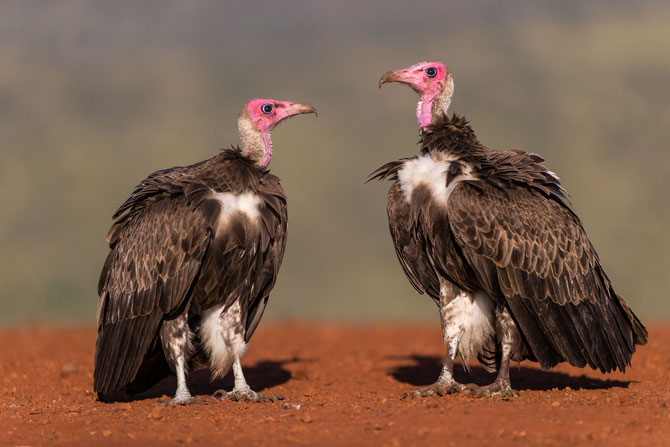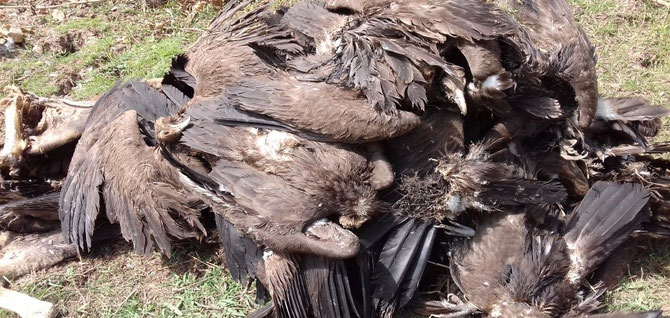
A recently published journal article shares interesting results derived from studying the movements of 30 GPS tagged Hooded Vulture across eastern, western and southern Africa. Tracking studies are important to inform conservation plans and actions, especially when it comes to species on the brink of extinction like the Critically Endangered Hooded Vulture (Necrosyrtes monachus).
Methods
Different field teams trapped, caught and tagged 30 Hooded Vultures with GPS transmitters between 26 September 2013 and 28 June 2017 across six countries (South Africa, Botswana, Ethiopia, Kenya, The Gambia and Mozambique) for their independent studies. They defined the age of the birds as nestlings, immatures and adults, depending on their plumage characteristics. They also determined the gender of eleven of those birds (five female and six male) through molecular DNA analysis. The research team pooled all their data together and examined variability in space use through assessing monthly home-ranges and the amount of time that they spent in urban areas, in close proximity to humans, also known as “commensalism”.
Results
The research team evaluated whether the home-range size of Hooded Vultures was affected by factors such as age, breeding season or region.
The breeding season didn’t have a significant impact on the home-range size of Hooded Vultures, but there was a big disparity among birds from different African regions. The monthly home-range sizes for Hooded Vultures from southern (12,453 km²) and eastern Africa (3735 km²) were 103 and 31 times larger than those of conspecifics from western Africa (121 km²). This variation can be linked to the different feeding strategies these species adapt influenced by their regions, which can be influenced by resource availability and persecution.
The birds in western Africa are a different subspecies to the Hooded Vultures in southern and eastern Africa. The northern subspecies in West Africa often feed at rubbish dumps or on scraps left by people at markets and are usually accustomed to people. In contrast, the southern subspecies in southern and eastern Africa mainly feed in the wild, away from people. This suggests that the food availability for Hooded Vultures in West Africa is predictable as they know when and where to find it, so they do not forage long distances in search of food, which translates into comparatively tiny home-range sizes. In contrast, the Hooded Vultures in southern Africa travel extensively in search of food, covering long distances because they cannot determine when and where they can find their next carcass, which results in enormous home-ranges. The research also indicates that younger birds have much bigger home-ranges than adults, possibly because they are exploring new areas as they have not settled down to a nest site yet.
In terms of the conservation implications of the study, the analyses show that younger individuals and Hooded Vultures from southern and eastern Africa, which range over more extensive areas may be at higher risk of threats than adults and individuals from western Africa. Travelling greater distances may expose birds to more threats, particularly to more poisoned carcasses. Wildlife poisoning is vultures’ biggest threat in Africa and worldwide according to the Vulture Multi-species Action Plan we co-developed that was endorsed by the Convention of Migratory Species. However, this is not always the case as recent incidents unfolding in Guinea-Bissau, West Africa, resulted in the biggest ever vulture mortality event in the world with estimates of over 2,000 Hooded Vultures poisoned to death due to belief-based use. This perhaps illustrates the potential vulnerability of highly “commensal” species such as Hooded Vultures which often spend a lot of time in close proximity to people, particularly in West Africa as shown by this study.

The research team further calls for the age class and sex of poisoned Hooded Vulture to be determined as such information is often missing but can be very useful for risk assessments and impact studies. However, this is not always easy or possible, depending on the region and capacity.
What is perhaps most important to emphasise is the need for cross-border collaboration and coordination of all relevant stakeholders. Even though this species is non-migratory, the movements of these tagged birds indicate that they cross international borders very regularly, so international collaboration is essential to aid vulture conservation.
This research was all thanks to the following contributors: Lindy J. Thompson, David R. Barber, Marc J. Bechard, Andre J. Botha, Kerri Wolter, Walter Neser, Evan R. Buechley, Richard Reading, Rebecca A. Garbett, Pete Hancock, Glyn Maude, Munir Z. Virani, Simon Thomsett, Hansoo Lee, Darcy Ogada, Clive R. Barlow and Keith L. Bildstein.
Source
Thompson, L., Barber, D., Bechard, M., Botha, A., Wolter, K., & Neser, W. et al. (2020). Variation in monthly sizes of home‐ranges of Hooded Vultures Necrosyrtes monachus in western, eastern and southern Africa. Ibis. doi: 10.1111/ibi.12836
Sign up to our newsletter and never miss any vulture news!
